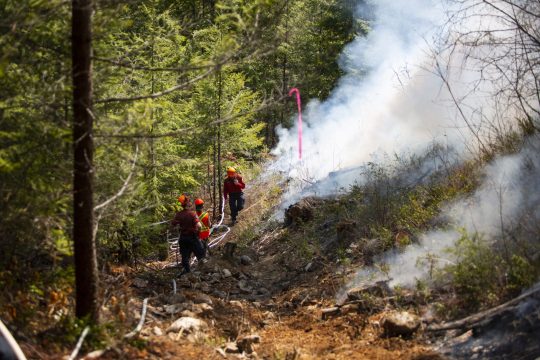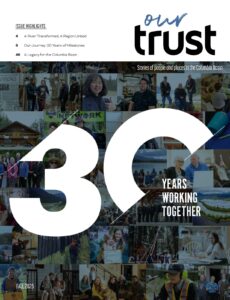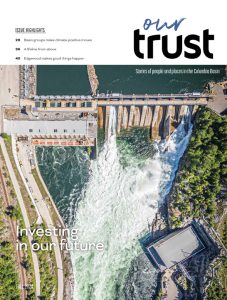Targeted grazing using new technology aims to keep the people of Cranbrook safe.
Cattle lumbering across the rolling land, flicking their tails, cocking their ears and slowly chewing on grass. You wouldn’t think this would be an effective strategy to reduce the risk of wildfires to a community, but a project south of Cranbrook plans to prove it is.
In brief, grass feeds fires and cows eat grass.

One of the project leads, Mike Pritchard, is a rancher, Wildfire Prevention Coordinator with the BC Cattlemen’s Association (BCCA) and former long-time employee with the BC Wildfire Service. He says, “Grass is the most volatile fuel type out there. A lot of our fuel reduction treatments historically have been about the removal of conifers, because that was sort of the big-ticket item—everyone saw the flames coming toward the community. But as you remove these conifers, you open the stand up, allow more sun in and make more water available, because trees take up a lot of water. The grass starts to grow. It’s trading one fuel type for another.”
The issue then becomes, “What do we do with the grass? Why not just let the cattle, the four-legged guys, wander around in there and mow it for us?”





This, therefore, is what the project aims to do on a 13-kilometre-wide stretch of Crown land bordering Cranbrook, where conifers have already or will soon be removed. The project is supported by the Trust through its Grassland and Rangeland Enhancement Program, delivered by the Kootenay Livestock Association, and key partners like the BCCA and the BC Ministry of Forests, Lands, Natural Resource Operations and Rural Development.
Since 1961, Jordy Thibeault and his family have been grazing cattle on a section of this land.
“Where this project is taking place, the cattle have always had access to the entire thing, which is about 40,000 acres,” he says. “Now we’re going to attempt to keep them contained on a targeted area of about 700 acres for a period of time, as long as it takes them to graze down to the intended degree of use.”
In addition to reducing fuel, this also makes the remaining grass healthier. “They utilize grass for a shorter period of time and then the grass gets a longer restoration,” Thibeault says. “It stays greener in a vegetative state longer, and so it’s less likely to burn.”
Another innovative part of this project is how they’ll contain the cattle: with “virtual” fencing. While used in places like Europe, this equipment is rare in North America. Using GPS and cell-phone technology, the rancher defines the location of fences, and collars let the cows know when they get close to the boundary. If they proceed too far, a mild electric shock turns them back.
“The equipment and technology’s not cheap,” Thibeault says, “but it’s not going to be any more expensive than going out and having to build a physical fence, and then those physical fences have to be maintained and repaired. For me, the idea of being able to control where my cattle go and being able to monitor them is of very high value.”
Unfortunately, the virtual fencing hit a glitch: the technology used by the supplier in Norway isn’t usable here, as it’s based on the European 2G cell network. Until it can be adapted, hopefully by fall 2020, the project is proceeding using electric fencing instead.
The project is also increasing its impact in Thibeault’s and the neighbouring rancher’s Crown tenure land by adding items like permanent fences, gates and cattleguards; installing a water delivery system powered by the sun; and treating invasive species—all to benefit the cattle, the ecosystems they graze in and the wildlife that also use these spaces.
Residents of Cranbrook—who use these lands as “their backdoor to the wild,” Pritchard says—will also get to enjoy a new trail. Traditionally, there can be conflict between people (and their dogs) and cattle, so Pritchard hopes word spreads widely about this important project.
“We want to get the information out to folks in Cranbrook and say these cows are basically doing a job there” and protecting their homes, he says. “There’s cattle out there working for the community.”
Watch the 2022 documentary about this project and others like it here.














